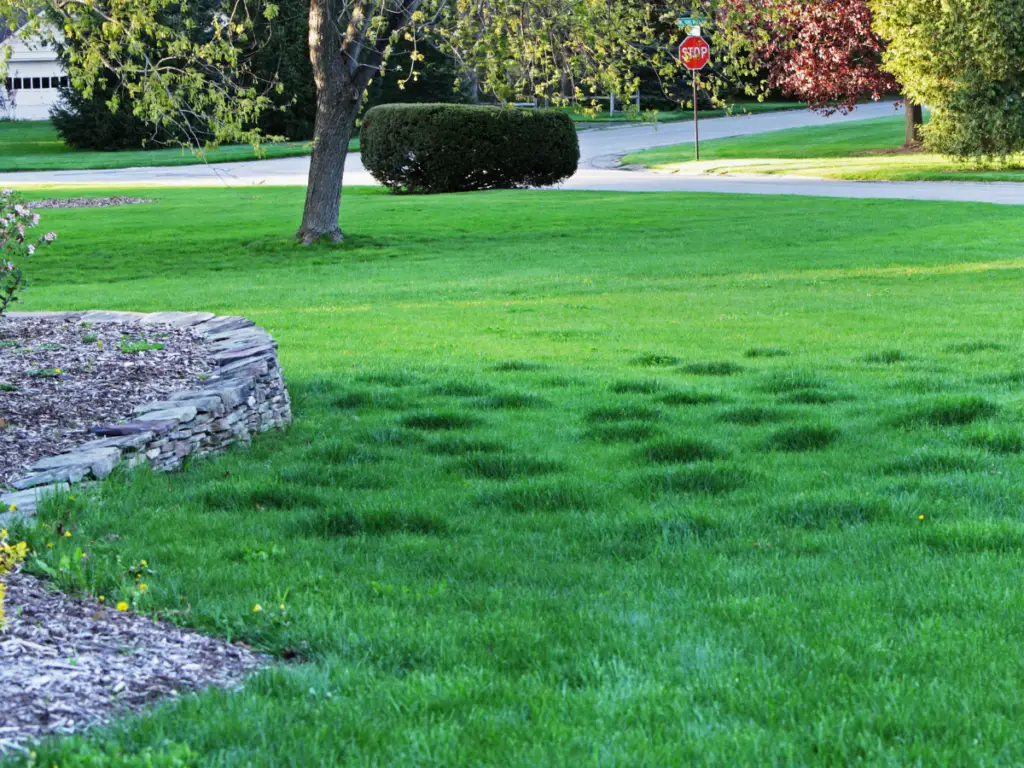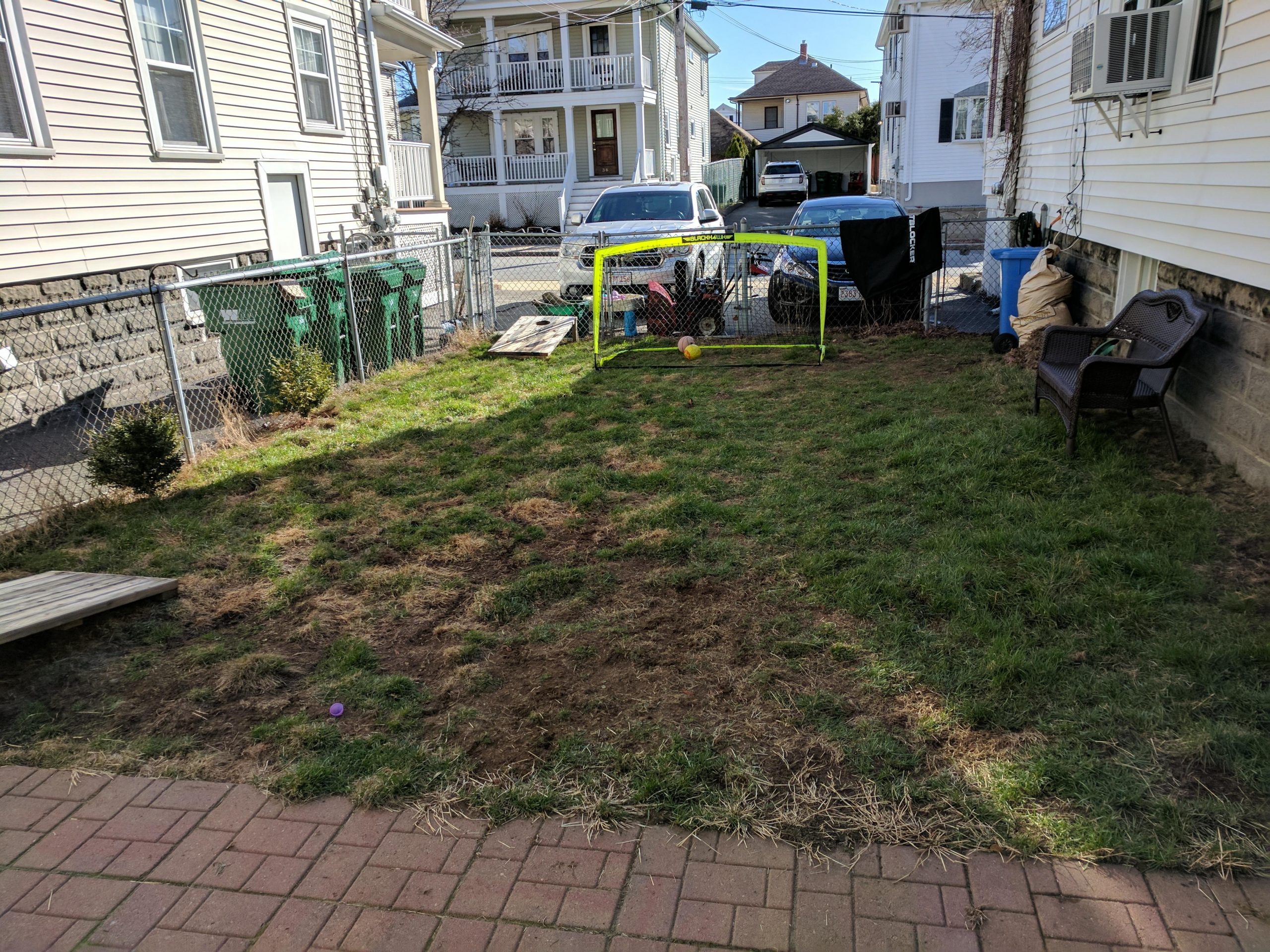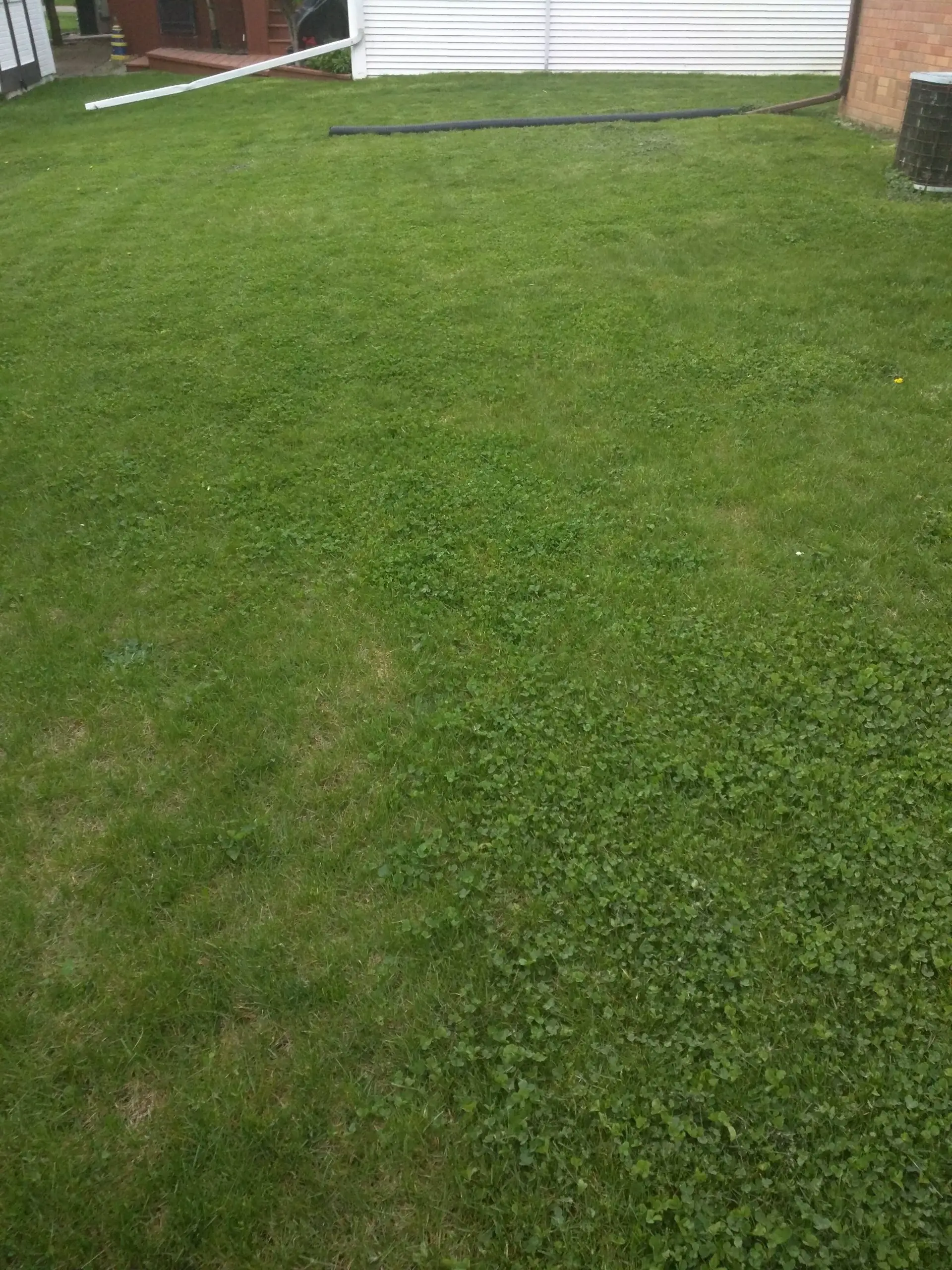Spread Lime Water Some More
Lightly spread horticultural lime over the affected spots. Don’t add too much lime follow the directions on the package closely. Too much can have the opposite effect and do more damage. Thoroughly water the spot again. Keep watering every day. Eventually, the natural green color of the grass will return. If it doesn’t return in a few weeks, you may have to dig out the area and reseed.
Insects Rodents And Birds
Insects , rodents, and birds work together to do damage to a healthy lawn. Certain beetle larvae, usually referred to as grubs, can infest the soil beneath the grass and attack roots. This can kill the grass and leave brown splotches on an otherwise green lawn. Animals such as moles, voles, chipmunks and skunks can riddle your yard with their tunnels and digging, often as in a skunk’s case looking to feast on grubs. Certain bird species can nibble on the grass leaves themselves, as well as make your attempts at seeding new grass more difficult.
Unfortunately, there’s not a lot you can do to prevent these attacks. While there are a number of available insect-control products and rodent-control products at your local True Value hardware store, it can be hard to stop all infestations. Usually, you just have to take your lumps and work on repairing your grass after the fact.
Is It Better To Pull Weeds Or Hoe Them
Pulling weeds is far more effective than cutting them with a string trimmer, hoe, or lawn mower. If you pull a weed out entirely, including the roots, then the weed will be killed and will not grow back. If you cut a weed instead of pulling it, the roots of the weed will try to send up new shoots over and over.
Recommended Reading: How To Kill Creeping Charlie But Not Grass
How To Repair Dog Holes And Other Lawn Damage
Dogs, especially puppies, have a lot of energy that they often devote to digging. They may dig for entertainment, to try and escape, or to hunt prey such as moles.3 It can take some time to train your dog to stop digging once they develop the habit, so intervene earlywith attention, training and praiseto stop digging problems right away.
Step in with quick lawn repairs to fix digging holes as soon as they appear:
For other lawn areas hit with doggy damage, turn to Pennington Lawn Booster. This all-in-one product combines premium Pennington Smart Seed, professional-grade fertilizer and soil enhancer. It’s guaranteed to grow quicker, thicker, greener grass in just one application.
Pennington, One Step Complete and Smart Seed are registered trademarks of Pennington Seed, Inc.
The Overview: Space Time Appearance And Uses

Pretend youre a stranger, and look at your lawn. How does it look, over all? Dont be your own worst enemy here, just be honest.
How big is the lawn? Knowing the square footage of your yard not only makes it easy to calculate seed and fertilizer needs, but it also protects you from awkward social situations, such as this sort of exchange at the seed counter:
Clerk: How much do you need?
You: Uh Uh
Clerk: Well, how big is your lawn?
You: Umm
Its best to get out there with a tape measure and do the math.
How much time do you spend caring for your lawn and how do you spend it? How often do you mow? Fertilize? Aerate? Do you rake up the grass after mowing? What do you do with it? Do you rake leaves? What happens to them?
Read Also: Does Lowes Rent Riding Lawn Mowers
Get To The Root Of The Matter
Start by dethatching your yard. Thatch is that thick layer of grass clippings and other organic material at the base of your grass. Too much starves your grass of oxygen and nutrients. Shovel out a triangular plug of grass thats a few inches deep. If the thatch layer is up to an inch thick when you press on it, its time to detach. Its best to do this in spring or fall.
Test For Dormancy With Proper Lawn Care
Start out by appropriately watering your lawn, weeding it, mowing it, and maybe even aerating your lawn. See how the grass responds.
If your lawn is just dormant, youll probably see a significant change once you start watering it as you should. You might not realize it, but simply mowing the lawn can be helpful because when you leave the clippings behind, they act as a natural fertilizer.
You can also try tugging on a few blades of grass. If they come out surprisingly easily, its probably because the roots are dead. If your grass is dormant, the blades will still be firmly rooted in the soil and difficult to pull from the turf.
Read Also: Killing Clover With Vinegar
Why Do Lawns Burn
Home lawn care products in the UK are designed to produce a quick green up. Get a Lush lawn in seven days and quick green up are their main marketing points. Unfortunately, these quick fix qualities are bad for your lawn. They needs to be very high in nitrogen for them to produce quick results. A high nitrogen fertiliser is very likely to burn the lawn if over-applied. This is compounded by the difficulty in applying these products. Good spreaders are expensive. Granules are difficult to apply without the correct lawn care equipment. Any spills will risk burning the grass.
Determining The Cause Of A Dead Lawn
When your grass turns brown and dry, either on parts of your lawn or across the whole area, you may be itching to lay down new sod or start another plan to revive your lawn. But if you want your new lawn to last, you first have to determine the cause of death for the old lawn. If you dont fix what was wrong, you may find yourself staring at another dead lawn in the near future. There are a few common causes of dead patches or dead lawns, and it may take some detective work to find which one is responsible for your dead lawn.
You May Like: How To Estimate Lawn Mowing Jobs
Repairing Holes / Pits In Your Lawn
If the holes / pits are only slight then repairing the grass should be a simple process and can be easily repaired with a little top dressing to level out the surface and reseed, but anything more than 1/2 deep you will need to follow the below steps:
Determine If Your Grass Dead Or Dormant
Determining whether your grass is actually dead or just dormant is important because it dictates what your next steps should be. If it salvageable, you can save time, money, and a lot of work by restoring it rather than starting all over. If not, no harm no foul.
Try these tests to see if you have a dead lawn or a dormant lawn.
Recommended Reading: Spray To Keep Geese Away
How To Repair Bare Spots In Your Lawn
Healthy green turf is a welcome sight as lawns spring to life after winter, but early days sometimes hold surprises. Even well-maintained lawns can yield bare or thin spots, but early spring provides excellent opportunities for corrections. Pre-blended, seeding mixtures eliminate the guesswork in spot repairs by delivering seed, mulch and fertilizer in a single, optimized product. Repairs are simplified, establishment is enhanced, and repaired areas should establish well before summer stresses arrive.
Reseed Lawn As Necessary

Depending on how much topsoil you had to put in to make your lawn even, you may find that you have some bare spots where grass doesnt grow through. If this is the case, replant using grass seed in those areas, following the steps you usually would, to patch the bare spots. Once the new grass grows in, youll be amazed at how smooth and even your lawn looks.
Read Also: How Much Does Truegreen Cost
Problem: Lack Of Sunlight Solution: Look For Lawn Alternatives
Even so-called shade-tolerant varieties of turfgrass wont do well in dark corners of the yard. And pruning trees too aggressively to create sunlight can end up harming the tree. Youre better off cutting your losses and replacing the sun-starved patch of grass with a shade-tolerant ground cover, such as bishops hat or sweet woodruff. Or you might convert that part of the lawn with gravel or a perennial bed.
Stop Crabgrass Before It Starts
- Apply crabgrass preventer to any areas where crabgrass previously grew, which is typically along the street, driveway and sidewalk.
- Pro tip: A hand spreader is perfect for small areas, like along the pavement where crabgrass tends to grow.
- Note: Crabgrass will grow when the soil warms up to 55 degrees F. If you apply the preventer too early, it will be ineffective. And once the seeds germinate, it’s too late. In northern states, late April is the best time. Mid-March is recommended for southern states.
- In mid-May, give your lawn its second application of lawn fertilizer.
Also Check: Lawn Mowing Estimates
Ways To Save On Lawn Care
Add compost. This will improve your soil and eliminate pests and diseases, which means less money spent on fertilizer and water. Apply a quarter-inch of top-dressing compost once or twice a year, including right after your lawn has greened up. Going over the lawn with an aerator first will help mix the organic matter into the soil.
Water wisely. An established lawn needs about 1 inch of water per week in the growing season. A light daily watering will encourage shallow root systems. Instead, water thoroughly once a week, using a 1-inch deep empty tuna can as a makeshift measuring device. Early morning is best, say before 8 a.m., when evaporation rates are low and more water is absorbed into the soil. Also, dont be afraid to let grass turn brown during dry spells. Most species can easily go a month without water. Its time to water again when the grass goes from tan-brown to straw-colored.
Mulch, dont bag. Your grass clippings are a free source of slow-release fertilizer, so let the mower discharge the clippings back onto your grass rather than bagging them. This can cut fertilizer costs by up to 30 percent. The only time to bag clippings is when your lawn is having a disease breakout, often signaled by irregular brown patches or rings in the lawn.
Ive Got Crabgrass In My Lawn
Theres no argument about it: Crabgrass is a troublemaker. The best way to treat it is to keep it from appearing in the first place. Use Scotts® Turf Builder® Halts Crabgrass Preventer with Lawn Food* in early spring to stop crabgrass from sprouting and protect your lawn all season long, while fertilizing at the same time for strong, lush grass growth. Crabgrass already making its unwanted presence known? Stop it cold with Scotts® Spot Weed Control for Lawns, which kills crabgrass down to the root without harming the lawn.
You May Like: How Much Lime To Put On Lawn
How To Plant Grass Seed In Bare Spots
Perhaps you are already familiar with how to seed your lawn. However, reseeding dead spots in a lawn calls for added attention to detail. We have outlined the steps on how to plant grass seed in bare spots for your next lawn repair.
- Remove Debris
Before you start seeding the brown patch, remove any leaves or debris from the area to avoid damage. This removes any obstacles in distributing the seeds evenly among the dead grass. If the brown patch in your lawn was caused by urine or chemical spills, thoroughly rinse the area several times before reseeding to dilute any harmful chemicals.
- Break up the Soil
Refresh the soil of the brown patch by taking a rake or a garden cultivator to till the ground in your summer yard. This will help ensure that the soil is loose and ready to take in the new seed.
- Add Compost
Using compost is a great way to add nutrients back into the soil. Add a 2 to 3-inch layer of compost or loamy soil and use the rake again to mix it with the existing soil.
- Even out the Surface
Use the top of the rake to make a flat and even surface to start sprinkling the grass seed.
Evenly distribute a thin layer of grass seed over your brown patch.
- Protect the Seeds
If you choose to sprinkle the seed on top without pre-mixing it in the soil, place a thin layer of straw over the area to prevent birds from eating the seeds. Once the grass starts to bud, remove the straw.
- Keep the Area Lightly Watered
- Lightly Fertilize
- Wait to Mow
- Monitor the Area
Do You Love Learning About Stuff Like This
A monthly newsletter for New Hampshire gardeners, homesteaders and plant-lovers of all kinds, that includes seasonal suggested gardening tips, upcoming events and articles with proven solutions for your garden and landscape.
Got questions? The Ask UNH Extension Infoline offers practical help finding answers for your home, yard, and garden questions. Call toll free at 1-877-398-4769, Monday to Friday, 9 a.m. to 2 p.m., or e-mail us at .
Read Also: How To Revive Lawn
How To Fix My Ugly Lawn And How Long Will It Take
An ugly lawn can be very frustrating. You might feel as though youve tried to give your lawn what it needs but you still see weeds popping up or bare spots where no grass is growing. Or maybe you know youve neglected your lawn for a season or two and now it just seems beyond repair.
You may not be sure whats involved with fixing an ugly lawn.
For one, you may not be sure how much time it will take to fix your lawn. And without any lawn care expertise of your own, you might feel concerned that youll make the wrong choices and prolong the process.
It may all feel a bit overwhelming. You just want to restore your lawn with as few headaches as possible.
Thats why youre looking to understand the best methods to achieve your goals. Youd like a realistic timeline of how much time it will take, as well as what actually needs to be done to get started on improving your lawn.
Will The Uneven Areas Remain Level

Answer: Assuming you solved the problem that caused the unevenness to develop in the first place, theres no reason your leveled lawn should not remain that way for many years to come. That being said, unless your installing artificial turf, any type of natural grass is subject to erosion, drought, or disease, which if left untreated could kill the grass. In that event, your likely to face uneven lawn conditions in those areas.
You May Like: Rechargable Lawn Edger
Why Overseed In The Fall
It’s fine to overseed in spring, although many people wait too long and end up seeding in the summer when it’s much more difficult to get new grass to grow. However, if you’re in the habit of applying a crabgrass prevention herbicide, you can forget about spring seeding. Most pre-emergent herbicides inhibit all seed germination for up to 12 weeksand that puts you right in the middle of summer. Instead, it’s best to overseed right after aerating the lawn, which is ideally done in the fall.
How To Fix Dead Grass
Foot traffic and weather extremes like drought and flooding can damage your lawn, leading to patches of dead grass. Repair these spots now for a lush lawn spring, summer and fall.
This simple process requires just a single product, and depending upon the number of patches, not much of your time. Start with a grass seed product that combines seed, fertilizer and mulch.
You May Like: How To Estimate Lawn Mowing Jobs
Problem: Ugly Bald Sports Solution: Start From Scratch
Weeds love bare patches, so if you dont act quickly, they will. Springs cool, wet weather is conducive to growing many types of turfgrass. Start by digging up the damaged section, plus 6 inches of surrounding, healthy lawn, cutting about 2 inches deep. Then level the soil and add a small amount of soil amendment, such as a plant-based compost, and starter fertilizer. If youre using seed, cover it lightly with straw and keep the ground moist until germination. For sod, which is about 10 times more expensive than seed but tends to work better, cut a section to fit, press it into place, and water frequently until it takes root.
